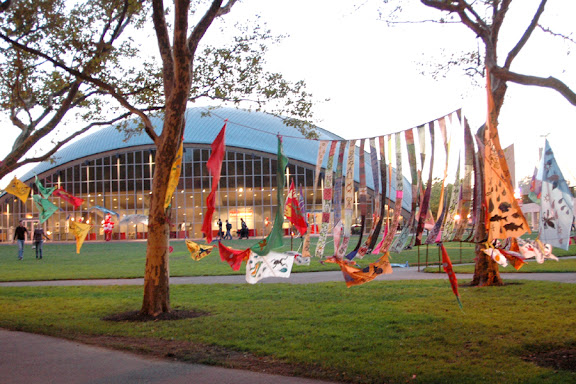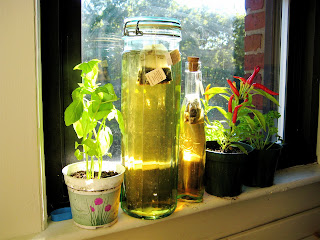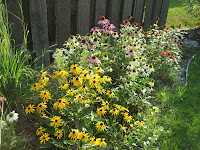I promised to write the next post about cars, so here it goes.
The take-home message here is really that people are extremely generous with their cars -- so many people have lent them to us on the spur of the moment and it's hard to imagine that happening in many other places in this country. The other take-home is that it really is true that people out here generally have some 3-4 cars just so they can keep one working. Stephan claims that most of the cars here would never be allowed on the roads in Germany...
And now, here's the story...
First we were supposed to borrow a car from the tribal government for the summer, but since we are not tribal memebers we couldn't use their insurance so that plan fell through. But, alas, you can't get anywhere around here without a car so we started borrowing various cars from our different host families and extended families.
 Car #1: Mike's old red truck
Car #1: Mike's old red truckThe first one was an old red truck, featured in our last video. I have no picture of it, unfortunately. We drove it for the first time when we were still very unfamiliar with directions and made some wrong turns, mooing all the way...
Features:
-> Makes a distinct mooing noise with every turn
-> Blinker does not click in and out, you just have to guess whether or not you have the blinker on or not
-> Automatic, which means I can drive it
-> Does not indicate on the dashboard whether you are in Neutral, Drive, or Reverse, etc (you just count, like I do in the video)
-> Seat cannot move forward far enough for Allison to reach the pedals, so I was the exclusive driver of this vehicle
-> A good 30 degrees of free play at the top of the wheel (you turn the wheel 15 degrees in either direction and the wheels stay straight)
-> Fuel gauge reportedly bounces around once it gets below 1/4 tank, so you don't know when you'll run out of gas
And we discovered a new one when we were proactive in dealing with the last of these 'features' and took it to a gas station. The entrance to the gas tanks has been dented so it only takes gas if you feed it in a little bit at a time.
 Car #2: Mike's new red truck
Car #2: Mike's new red truckWe borrowed this one for a week or two, and it is by far the nicest car we have had out here. Thankfully it was the one we drove up to Rapid City to pick up Stephan and visit Mt. Rushmore and Crazy Horse.
I have no picture of this one either, but here's a neat one of it's tailgate after we just passed under a pretty bridge.
Features:
-> Manual (but the seat moved forward!) so Allison drove it
-> In great condition
-> It takes $80 to fill up the tank and we sure burned through it in a hurry
-> Stephan was so shocked when we picked him up in this vehicle, since it is about three times the size of most cars in Germany
The surprise feature that we only found out after Mike got back from a week trip to Kansas City is that the oil leaks and we were supposed to check it every few days. Oops. Luckily it kept running fine. I guess no car can be perfect out here.
.JPG) Car #3: Bob's white station wagon
Car #3: Bob's white station wagonOnce we moved into Pine Ridge with Bob's mom, we started borrowing a small white station wagon Bob had recently gotten up and running again. Apparently he bought it for $100 a while back and has put some $300 of parts into it. In the video, notice the difference in how Bob handles the cows compared to how we did...
Features:
-> Automatic, so both Allison and I can drive it. Stephan has never driven an automatic before, so he preferred not to drive it.
-> The brakes are really delayed and weak. One must drive very cautiously.
-> Does not accelerate well when going up hills
-> The battery doesn't disconnect when the car is off so you have to manually open the hood and pull it off each time you park, then fiddle with it until it can start the motor when you want to go again.
-> The air conditioner gave out while we were driving. We were advised to drive fast over speed bumps to try to knock the wire back into place
-> There is no dipstick for the oil
It started making weird noises one day, so we put in a quart of oil. The noises went away but we started spewing blueish smoke. Turns out we were burning oil. This cycle repeated until we realized we were buring oil faster than we could put it in and we left the car at a guy named Tim's house. This was probably a good thing since we later found out that the break lines were filled with power steering fluid rather than brake fluid and that this supposedly eats away at the rubber in the breaks and destroys them...
 Car #4: Tim's "trash truck"
Car #4: Tim's "trash truck"Ditching the white car at Tim's house left us without a way to get back to town, so Tim lent us his "trash truck." It is called the trash truck only because they use it to take trash to town, but it is definitely the oldest car I have ever driven.
Features:
-> No blinker
-> Automatic, but also doesn't tell you what gear you are in, although I have gotten rather used to that by now!
-> No key required to start the car. It must be started by flipping a switch that Tim wired into the car himself
-> No key required to open the door. You don't even need to push down the button, just pull on the handle and it opens
-> A good engine and good brakes!
-> It leaks power steering fluid, so you have to keep filling it up with that
-> It has the loosest wheel I've every touched -- not free play like the other truck. I turn it all the way around when making right and left turns at stop signs.
One day the latch mechanism in the door suddenly started working again, so we had to break into the car with a butter knife (by unscrewing the triangular shaped window pane, rolling down the main window, and unlocking the door). Other than that we haven't had too many adventures with this car, which is a good thing.
Car #5: Bob's blue "boat"
We've never actually driven this car, but we have ridden in it. I is a huge old Chevrolet and really feels like a boat when you are riding in it, sailing over the waves of grasses blowing in the wind....
Car #6: Bob's green station wagonBob's almost got this one fixed up and we'll likely be using it soon so we can give Tim his trash truck back. He says it works great, it is just missing a door handle on the front passenger side. We'll take it : )
 This is the gorgeous outdoor sculpture that goes with the event.
This is the gorgeous outdoor sculpture that goes with the event.
 With this information, they added to a growing collage featuring a map of how climate change is going to impact agriculture in the world.
With this information, they added to a growing collage featuring a map of how climate change is going to impact agriculture in the world. Here is one of the resulting hexagons.
Here is one of the resulting hexagons. Then they started stamping shirts, cloth grocery bags, and fabric pieces with stamps related to food and water. Here are some more photos.
Then they started stamping shirts, cloth grocery bags, and fabric pieces with stamps related to food and water. Here are some more photos. This will later get sewn up into a hand-made grocery bag.
This will later get sewn up into a hand-made grocery bag. A father looking on as his daughter stamps.
A father looking on as his daughter stamps. Stamping onto a bag made of the burlap from a coffee sack brought in from Latin America. We have burlap sacks from Costa Rica, Colombia, and Brazil among others.
Stamping onto a bag made of the burlap from a coffee sack brought in from Latin America. We have burlap sacks from Costa Rica, Colombia, and Brazil among others.



























.JPG)













